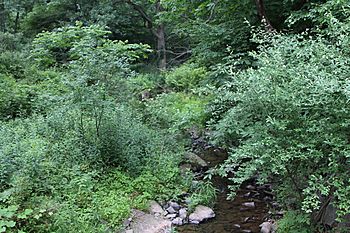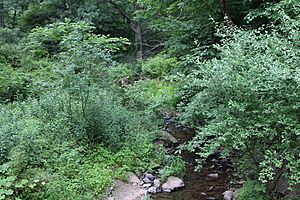Kingsbury Brook facts for kids
Quick facts for kids Kingsbury Brook |
|
|---|---|

Kingsbury Brook in its lower reaches
|
|
| Physical characteristics | |
| Main source | valley southeast Southdale, in Huntington Township, Luzerne County, Pennsylvania between 820 and 840 feet (250 and 260 m) |
| River mouth | Huntington Creek in Huntington Township, Luzerne County, Pennsylvania 692 ft (211 m) 41°08′04″N 76°16′21″W / 41.13455°N 76.27248°W |
| Length | 1.5 mi (2.4 km) |
| Basin features | |
| Progression | Huntington Creek → Fishing Creek → Susquehanna River → Chesapeake Bay |
| Basin size | 1.27 sq mi (3.3 km2) |
| Tributaries |
|
Kingsbury Brook is a small stream, also called a tributary. It flows into Huntington Creek in Luzerne County, Pennsylvania. The brook is about 1.5 miles (2.4 km) long. It flows through Huntington Township. The area of land that drains into it, called its watershed, is 1.27 square miles (3.29 km2). Two smaller streams, called tributaries, flow into Kingsbury Brook. Wild trout live and have babies in the stream. The ground around the stream has different types of soil and rocks. These include alluvium, till from glaciers, and bedrock. There are also some wet areas called wetlands.
Contents
The Journey of Kingsbury Brook
Kingsbury Brook starts in a valley. This is southeast of a place called Southdale. Southdale is in Huntington Township. The stream first flows southwest for a short distance.
How the Brook Changes Direction
After starting, the brook turns south-southwest. Then it turns west-southwest. It flows through a small pond along the way. Next, the stream turns southwest. Here, it gets water from an unnamed tributary on its right side.
Meeting Other Streams
The brook then turns south for a short distance. It crosses State Route 4006. After this, it gets more water from another unnamed tributary. This one joins from the left side. A short distance later, Kingsbury Brook flows into Huntington Creek. This meeting point is about 6.08 miles (9.78 km) upstream from where Huntington Creek ends.
Smaller Streams Joining In
Kingsbury Brook does not have any named tributaries. But it does have two unnamed ones. The first one is about 0.7 miles (1.1 km) long. The second one is about 0.8 miles (1.3 km) long. This second tributary flows through several ponds.
Land and Rocks Around the Brook
The land around Kingsbury Brook has different heights. Near where the brook joins Huntington Creek, the land is about 692 feet (211 meters) above sea level. Near where the brook starts, the land is higher. It is between 820 and 840 feet (250 and 256 meters) above sea level.
Types of Soil and Rocks
The ground along the lower parts of Kingsbury Brook has mostly alluvium. This is made of layers of sand, silt, gravel, and some large boulders. Along the sides of the valley, there is some Wisconsinan Ice-Contact Stratified Drift. This is also made of sand and gravel, with some boulders.
Further from the stream, you can find a type of glacial soil called Wisconsinan Till. There is also a patch of Wisconsinan Bouldery Till. The areas near the start of the stream mostly have Wisconsinan Till. In some spots, the ground has bedrock. This bedrock is made of sandstone and shale.
The Kingsbury Brook Watershed
A watershed is an area of land. All the rain and snow that falls in this area drains into a specific stream or river. The watershed for Kingsbury Brook covers an area of 1.27 square miles (3.29 km2). The entire stream is located within the Stillwater area. This area is mapped by the United States Geological Survey.
History of the Brook
Kingsbury Brook was officially added to the Geographic Names Information System on August 2, 1979. This system keeps track of names for places in the United States. Its special ID number in the system is 1178500.
There is a wet area, or wetland, near the lower parts of Kingsbury Brook. The stream also flows close to the community of Southdale.
Animals and Plants in the Brook
The area that drains into Kingsbury Brook is special. It is called a Coldwater Fishery. This means it's a good place for fish that like cold water. It is also a Migratory Fishery. This means fish that travel to different places use this stream.
Wild trout naturally live and have babies in Kingsbury Brook. They can be found from where the stream starts all the way to where it joins Huntington Creek.


